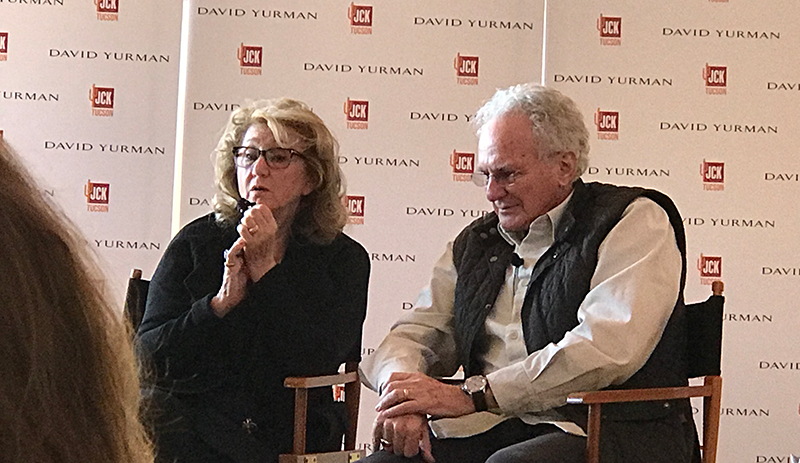
David and Sybil Yurman discuss their company’s origins at an invitation-only event in Tucson.
David and Sybil Yurman started their business with a $500 loan co-signed by their parents.
“We wanted to make things,” Sybil says. “We didn’t set out to build a business. We wanted to be hanging out and designing. But we had to be able to sell what we made, and that was a daunting experience.”
But build a business they did, along with an iconic brand focused on a cable motif. Today they have 40 boutiques in the U.S. and hundreds of shop-in-shops worldwide.
The couple spoke at an intimate, invitation-only event Feb. 1 during the JCK Tucson show.
David says it’s a promising time for jewelry designers because there is a strong movement currently to want to “see and touch things,” an inclination he tapped into from his background as a sculptor.
Advertisement
When he began making jewelry, transitioning from the craft world to jewelry stores was a formidable leap and entering the mainstream brought with it the danger of losing brand identity. “Craft had all the feeling, all the juice, then; we were having fun. The best expression of jewelry is joy. We wanted to make jewelry that was accessible and attractive to all kinds of people.”
We wanted to make jewelry that was accessible and attractive to all kinds of people.
There was the craft world on one side and the American jewelry market on the other with a virtual ravine separating them.
Castings were purchased from Europe and gemstones were purchased separately, combined and sold in stores. But jewelry legend Mort Abelson, director of the JA International trade shows, allowed those worlds to collide by recruiting jewelers from the craft world to display their work at wholesale shows.
David Yurman was the first major designer to set diamonds in sterling silver. He broke the mold, too, simply by making silver jewelry as fine jewelry, adding gold accents so that goldsmiths would deign to work on it. “Getting jewelers to work on silver in a fine manner was very difficult and very unusual,” Sybil says. Another hook was the fact it was made in America.
There was resistance to branding in jewelry stores, too, so changing that tradition called for a fight. He insisted that retail partners not take credit for his work. He would only sell to them if they bought a collection and if there was enough space in the store to properly display and credit it. “It could be 20 pieces but it had to be from one collection. There had to be enough to tell the story.”
Advertisement
The Yurmans devised a contract to deal with the stores. “We didn’t do it out of arrogance, but out of a certain kind of ignorance about the way things were done,” Sybil says, “not realizing how regimented it was.”
They also had to deal with the fact that retail jewelers did not want to reorder pieces that sold. They would sell one piece and want to know what was new.
Persistence paid off.
“If we did it with $500 you can do it, too,” David says. “We weren’t a lot better or a lot smarter. We took the ground. Mom and Pop stores were getting tired of seeing the same old stuff over and over again. The whole craft movement started bringing all this handmade point of view. We brought a lot of juice to them.”
And eventually they went into retail so that they could tell their story the way they wanted it to be told.
What is David Yurman’s advice for jewelry designers and retailers today?
- Decipher what the demand is while keeping true to your aesthetics. “Bring in your best customer and let her know that you want her input,” David says. “Say, `What would you like to see that I don’t make?’ You hate earrings? When is it about you? Make some earrings!”
- Don’t design in a silo. Get out of your studio, and see what’s going on, not to copy but to understand the flow and direction of the industry, and perhaps, to see what you don’t want to be making, because it may belong to someone else. Follow your own dreams. Recognize your heart’s desire. Your brain has a billion ideas.
- The tendency for designers is to just make too much. “It just feels good to design,” David says. “So get someone in your family to say put out 10 now and next year put out another 10.” Let that same person remind you that you have already made that design you convinced yourself was brand new.
- Branding yourself? Don’t count out print advertising. “Seventy percent of the people who buy my products read magazines, in print,” David says.
- Find your own river. David and Sybil describe the themes that runs through a designer’s work as a river. Today, 70 percent of what the Yurmans sell has a cable motif, and many of the best-selling designs were made 20 years ago.
- Recognize there’s a trend toward interesting, earthy gemstones. “I’m seeing stuff I saw in the ’60s and ’70s, picture jaspers, plume agates. Italians call them earth stones. You can feel the earth in the stones. You don’t have to be an expert to tell that they are all unique.”
- Experience is key, David says. “We’re not just artists doing what we want to do. If you have a store and a customer base you have to surprise them.” If you’re in the retail business, “It’s a party. Open the door and you’re inviting people in to your party, to your feast. And they can take something home with them.”
This story is an INSTORE Online extra.
Advertisement